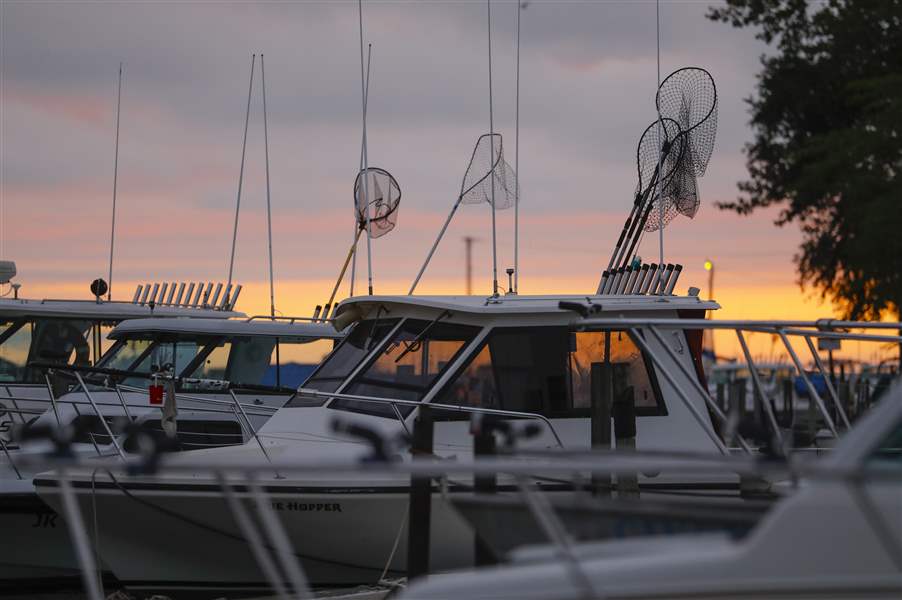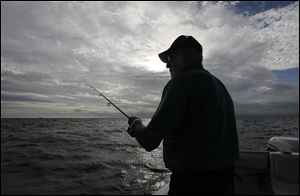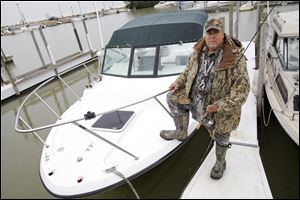
WALLEYE WORLD
Lake Erie remains gold mine for fish
6/22/2018
Charter fishing boats are lined up at Wild Wings Campground and Marina in Oak Harbor.
The Blade/Andy Morrison
Buy This Image
PORT CLINTON — Prehistoric native tribes were likely the first to feast on Lake Erie’s abundant supply of walleye. A missionary working in the region in the late 1700s called the same fish a perch with "sharp teeth like those of a pike.”
That fish is now responsible for the majority of a sportfishing economy that churns out a $1.3 billion impact annually in the lake’s Ohio waters alone.

Capt. Dave Spangler of Dr Bugs Charters fishes for walleye on Lake Erie on Tuesday. For charter captains and fishers of all stripes, the fishery in northwest Ohio is one of the richest in the world.
This fish — Sander vitreus — fetches $15 to $18 per pound for its fillets at the market and supports a licensed charter fishing fleet of nearly 700 boats along Erie’s Ohio shoreline. Much of that flotilla is based within 30 miles of this Ottawa County community, which puts these fishing machines in close proximity to what is generally considered the best walleye fishing in the world on western Lake Erie.
“We’re sitting on a walleye gold mine, right here in northwest Ohio,” said charter captain Mike McCroskey, who has been fishing in Lake Erie’s rich Western Basin for more than 40 years. “Lake Erie is an amazing place. You don’t find this many walleye, and so many big fish, anyplace else. There’s nothing even close. This is as good as it gets for walleye fishermen.”
Tournament angler Steve Miller, who fishes walleye waters throughout the country, added his perspective several years ago during a Cabela’s National Walleye Tour event on Lake Erie.
“If you live within an hour of this water, you are spoiled rotten,” Mr. Miller said after his five-fish limit for the first day of the tournament weighed in at 34.70 pounds. Although he averaged nearly seven pounds per fish, Mr. Miller found himself back in 52nd place in the field of nearly 130 anglers. “And if you don’t believe that, then follow me back to Iowa and we’ll catch some bluegills.”
WATCH: Northwest Ohio ‘couldn’t be a better place’ for walleye — and their anglers
Lake Erie has been producing walleye in prodigious quantities for more than a century. Commercial fishing for walleye, also known as pickerel in some parts of North America, got its start on the lake shortly after the end of the War of 1812, and as netting equipment and techniques improved, the commercial harvest grew steadily, reaching about 1.4 million pounds by 1885.
By the middle of the 20th century, an abundance of fish and an expanding market for the walleye’s mild, firm meat with a slightly sweet flavor prompted significant growth of the commercial harvest to as much as 15 million pounds annually.
“This stuff is delicious and everybody loves it; even people who say they don’t like fish, they enjoy eating walleye,” Mr. McCroskey said about the fish, which has 21 grams of protein and just 101 calories in a grilled three-ounce serving.
Sean Moran, the executive chef at the Toledo Club, said walleye is an excellent choice for the table because of its flavor and versatility.
“It is a very good fish to have on the plate, especially since it is very mild and you can do a number of things with it,” he said. “I also like the fact that it is local, and when you put walleye on the menu anywhere, you can’t keep it in stock. It is very popular.”
But while walleye fishing seems like a constant part of life now in northwest Ohio, the fishery has seen its fair share of ups and downs over the years, brought on by both human and ecological forces.

A walleye rebound
Starting around the late 1950s, walleye populations plummeted, likely because of pollution in the lake harming spawning sites and overharvest. The earlier construction of dams in many of the waterways walleye used for spawning was also considered a factor in the decline.
The commercial harvest in 1966 was just 163,000 pounds, and as the health of the lake continued to deteriorate, the Cuyahoga River caught fire in 1969 and splashed a national spotlight on Erie’s woes.
Warnings were issued concerning rising mercury content in Lake Erie walleye, and the species was mandated off-limits to commercial fishing in 1970.
“The lake was a pea green soup and walleye fishing had collapsed. It was in the dump and things were so bad that some people thought it would never get better,” said Roger Knight, the retired Lake Erie Fisheries Program Administrator for the Ohio Department of Natural Resources, Division of Wildlife, who worked out of the Sandusky Fisheries Research Station.
Mr. Knight, who spent nearly 30 years with the ODNR, said the Clean Water Act in 1972 started a slow turnaround for the lake and its walleye fishery.
“As the environment cleaned up, the fishery responded,” he said. “By the time the mercury content in the walleye flesh had dropped to a safer level, the sport fishery in Ohio was going strong and the commercial fishery for walleye never reopened. It was a legislative decision, and a socio-economic decision.”
The Lake Erie fisheries were also benefiting from the implementation of a multi-agency management approach, with partners from the eight states that border the Great Lakes, the Canadian province of Ontario, and certain Native American tribes in the U.S. combining resources, data, and personnel and working together on the Great Lakes Fishery Commission.
The Lake Erie Committee of the Great Lakes Fishery Commission, made up of representatives from Ohio, Michigan, Pennsylvania, New York, and Ontario, manages the fish stocks in the lake. Since 1976, it has set total allowable catch (TAC) quotas for walleye and yellow perch in each jurisdiction, based on population surveys and estimates. Ontario still allows commercial fishing for walleye, so most of its walleye quota goes to that fleet, which supplies the walleye sold in markets in Ohio.

As the lake’s walleye population continued to grow into the decade of the 1980s, concerns grew over walleye being killed in the gill nets that targeted other species, and by 1983 the gillnet fishery was bought out by the state. The trajectory of the walleye fishery likely hit its post-commercial fishing peak in the late 1980s.
“For sportfishing, the 1980s were the perfect storm of an environmental recovery based primarily on the Clean Water Act, and large walleye hatches over a number of years that fueled lots of angler interest in Erie’s Western Basin,” said Travis Hartman, the current Lake Erie Program Administrator for the ODNR.
In 1988, anglers working the Ohio waters of Lake Erie harvested about 4.9 million walleye, the highest sportfishing harvest on record. There were more than 1,200 charter fishing operations working the Ohio waters of Lake Erie during the boom years.
“We had a couple of great hatch classes in the ‘80s, and the next five years after those put Lake Erie on the map,” Mr. Knight said. “Lake Erie’s reputation as a quality and quantity fishery was building, and we hit that peak catch in 1988. The old captains said they would see schools of walleye a mile wide and you would just drift through and everyone got their fish.”
Another comeback
The fishery then slumped after hitting that high point, part of what Mr. Hartman said is the cyclical nature of the walleye population.
“When you look at last three decades, it is clear that we are going to go through environmentally dictated highs and lows, and with walleye those periods can be drawn out,” he said. “A series of poor hatches can swing things one direction, while one very good class can really fuel the fishery for several years. In the ‘80s we had a decade of mostly good hatches that really carried us.”
In the late 1990s and early in the 21st century, about a half dozen years went by with poor or average hatches. Then the fabled Lake Erie walleye class of 2003 came along and blessed the lake with its bounty. It was the largest recorded in the 30 years that fisheries experts have been tracking the hatches.
To arrive at an estimate of the walleye hatch throughout the basin, biologists from Ohio and Ontario drag trawl nets behind their boats, sampling roughly 80 separate areas of the lake’s western end, meticulously duplicating techniques and sites. They combine the data from their bottom trawl surveys to arrive at a hatch figure. The long-term average of young-of-the-year walleye detected in the trawls is 32 per hectare (about 2.5 acres). The 2003 hatch boasted more than 155 walleye fry per hectare.
In 2007, the walleye sportfishing harvest in Ohio waters hit 2.2 million fish, buoyed by the huge hatch in 2003 that is still producing trophy fish in the lake. The annual angler harvest in recent years has been around one million fish, but Mr. Hartman said he expects to see that figure jump because of the fact the fish produced in the very large walleye hatch in 2015 have matured into catchable-size keepers.
“The walleye on the lake had taken a downturn, but that great hatch in 2003 really ignited a comeback,” said Rick Ferguson, who started fishing the lake in 1981 and today runs the Al Szuch bait shop in Curtice. “It’s been up and down over the years, but the walleye population is in wonderful condition now thanks to that 2015 hatch. The fishing is really good, and it should just continually get better.”
Mr. Ferguson’s rosy optimism is shared by many. That robust walleye hatch in 2015, with more than 61 new walleye per hectare, was the best since 2003, and in the top five classes over the past 25 years. But there is evidence since that initial assessment that the 2015 class might be significantly larger than originally believed. Mr. Hartman said that netting surveys done in 2016 produced the most yearling walleye ever, including the 2004 survey that documented the yearlings from 2003.
“I would argue that the 2015 year class is potentially the biggest we’ve ever seen,” Mr. Hartman said.
Coupled with a historically average-size hatch class in 2014, the 2015 class has veterans of decades on the lake hearkening back to the walleye glory days of the 1980s.
“There’s fish everywhere,” said Mr. McCroskey. “Some estimates put the figure at 100 million walleye in the lake.”
Chip Gross from Morrow County has been fishing Lake Erie for walleye since the 1970s. He recalled the phenomenal fishery of the 1980s, and he sees similarities in today’s Western Basin stock.
“Back then, the fish were everywhere and charter captains were making two or three trips a day and limiting out with each group,” he said. “That lasted for a few years, but then things started to decline. The fishing got tougher and a lot of fishermen started to change from drifting to trolling, which produced a higher catch rate. You didn’t have to troll to catch lots of fish in the ‘80s.”
Mr. Gross said the 2003 hatch “really started us back up the ladder” and that the 2014 and 2015 classes have created an amazing fishery that is just starting to blossom. He said that on three successive days recently, a friend and the friend’s fishing parties caught 71 keeper-size walleye in six total hours of fishing, all at the same location on the lake off Vermilion.
“I don’t know how long it will last, but it looks very positive right now,” Mr. Gross said.
Taking care of what’s there
Mr. Hartman added that from a science and management standpoint, the understanding of Lake Erie walleye patterns is more solid than it has ever been. He said advances in research, technology, and equipment have made the current generation of walleye anglers the best ever at catching these fish.
“Everything has gotten better, but what we also know about Lake Erie is that you need to take advantage of what’s good, when it is good,” he said. “It’s not always going to be like this. We will still see great classes, and some poor classes, so we’ll go through tougher fishing at some point. But right now, it is as good as it’s ever going to be, with high catch rates and good numbers of trophy fish out there.”

Toledo resident Mike McCroskey, pictured in 2013 at Wild Wings Marina in Oak Harbor, has been giving guided hunting and fishing tours for more than 30 years and calls area the area a 'walleye gold mine.'
Erie, the shallowest and warmest of the Great Lakes, is a renowned fish factory. In contrast, Lake Superior has 50 percent of all the water in the Great Lakes, while Lake Erie has just two percent. But deep and cold Superior has just two percent of the fish found in all of the lakes, while Erie produces more fish than all of the other Great Lakes combined. Its many natural reef complexes in the Western Basin,composed of limestone and dolomite, provide exceptional spawning habitat for walleye.
All of the current exhilaration over the abundance of walleye in the western end of the lake does come with a caveat, however. A big, slimy, gooey, noxious green caveat that impacts the anglers much more than the fish.
“Right now, the fish are snapping all over the place, but I’m really concerned about what lies ahead in the next couple of months with the algal bloom,” said Captain Paul Pacholski, a veteran of 35 years on the lake and the president of the Lake Erie Charter Boat Association.
“Almost to a man, the other captains tell me their phones are not ringing as much for July and August because people fear the algal bloom will be back. We’ve had some great hatches, so if we can clean up our lake, then we can get back to the glory days of the ‘80s and ‘90s. The fish are there and there’s millions of them — we just have to take better care of the lake and protect this resource.”
Contact Blade outdoors editor Matt Markey at: mmarkey@theblade.com or 419-724-6068.